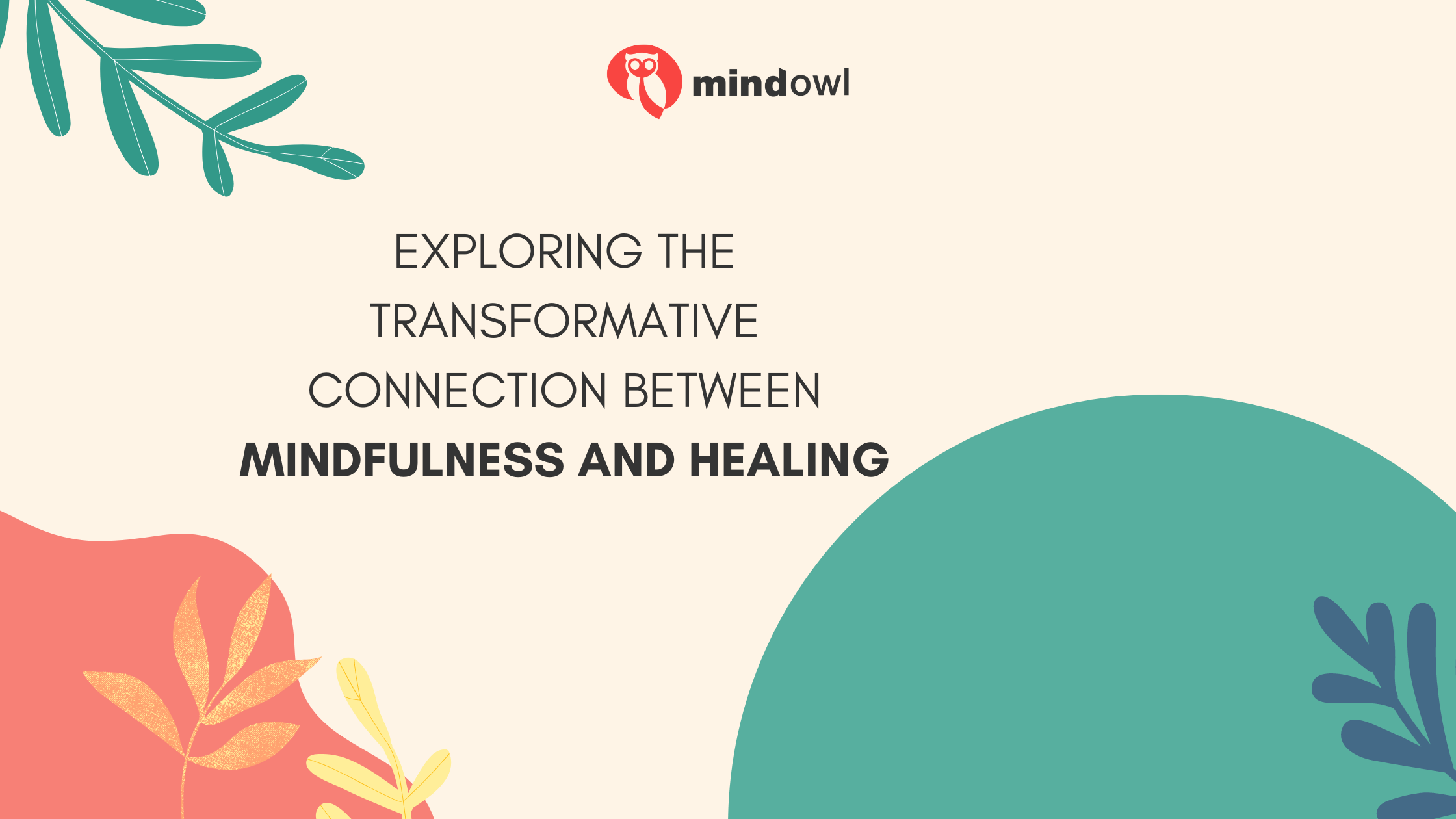In the rush and stress of daily life, finding peace can seem like a distant dream. Mindfulness, the practice of being present in the moment, is backed by evidence showing its transformative effects on health and healing.
This article reveals how embracing mindfulness could be your first step towards emotional and physical well-being. Let’s discover this powerful connection together.
Key Takeaways
- Mindfulness helps break negative thought cycles and increases emotional well-being, which can lower stress, anxiety, and depression.
- Practising mindfulness changes the brain to improve focus, and resilience against life’s challenges, and support recovery from illness by strengthening immunity.
- Mindful action for self-compassion is key in trauma recovery; it leads to increased self-awareness, better stress management, and a reduction in PTSD symptoms.
- Creating a safe space for oneself through mindfulness practices encourages healing of both mind and body.
- Jon Kabat-Zinn’s books provide practical advice on using mindfulness to improve mental health and address post-traumatic stress.

The Healing Power of Mindfulness
Mindfulness is not just about finding calm and peace; it has the power to heal both physically and mentally. By increasing self-awareness, breaking free from negative thoughts, and regulating emotions, mindfulness can bring about transformative healing in individuals.
How awareness heals
Awareness acts like a healing balm for the mind and body. Paying attention to the present moment can bring deep changes in how we deal with pain and stress. This practice lets us notice our thoughts and feelings without getting caught up in them.
We learn to see our experiences as they are, not worse than they are.
This kind of awareness helps us break free from negative thought patterns. By focusing on the here and now, we gain control over our emotions and reactions. Instead of being ruled by past worries or future fears, we stay grounded and calm.
Being aware makes room for kindness towards ourselves, which is key to healing.
Practising mindfulness increases emotional well-being. It’s proven useful for tackling high blood pressure, easing anxiety, and lifting depression. Each mindful moment strengthens emotional awareness and builds resilience against life’s challenges.
To nurture mindfulness as a way of being means inviting more peace into daily life.
Mindfulness as a way of being
Healing through awareness leads us towards embracing mindfulness as a way of living. Mindfulness means paying full attention to the present moment without judgment. It invites greater awareness into our daily actions, asking us to be fully engaged with life’s experiences as they happen.
This conscious approach extends beyond meditation practice; it shapes how we interact with others and respond to our environment. Living mindfully brings compassion and kindness into every aspect of life, from having breakfast to talking with friends.
It’s about observing thoughts and feelings without getting caught up in them.
Benefits for physical and mental health
Mindfulness offers us tools for a healthier life. It encourages both peace in the mind and strength in the body.
- Mindfulness improves our mental state. It can reduce anxiety, depression, and stress.
- It gives us emotional balance. We become less reactive and more resilient to life’s ups and downs.
- This practice helps with physical health too. People with chronic pain often feel better when they meditate.
- Mindfulness boosts well-being. Feeling good inside reflects on our outer health as well.
- Our brains change for the better with mindfulness. The practice enhances neuroplasticity, helping us adapt to new situations.
- Meditation increases our focus and clarity of thought. We can concentrate better at work or school.
- Mindfulness aids in restful sleep. A calm mind before bedtime leads to deeper sleep.
- It helps control blood pressure by managing stress responses within the body.
- Healing through mindfulness supports recovery from illness by boosting immunity.
Breaking free from negative thoughts
Negative thoughts can trap us in a cycle of unhappiness. Mindfulness helps us notice these thoughts without getting caught up in them. We learn to see our thoughts as passing events, not facts we must believe or act on.
This shift gives us the power to choose our responses, leading to healthier habits and emotions.
Practising mindfulness opens up space for positive change by teaching us self-compassion. It’s like building mental muscle; every mindful moment strengthens our ability to let go of negativity.
Over time, this training transforms how we deal with challenges, making room for healing and growth.
Increasing self-awareness and self-compassion
Breaking free from negative thoughts opens the door to greater self-awareness. People who understand themselves better can deal with challenges in healthier ways. Mindfulness meditation helps us see our feelings without judgment.
This makes us kinder to ourselves.
Practicing mindfulness leads to more self-compassion and empathy. It builds a stronger connection with our inner selves. This process heals both mind and body. When we accept ourselves, we start feeling better overall.
Mindfulness teaches us to be patient and supportive of our own journey toward healing.
Regulating emotions
Mindfulness meditation practice is like a tool for the mind. It helps you handle your feelings better. You learn to stay calm and not let bad moods take over. Imagine having a remote control for your emotions, where mindfulness is the stop button when things get too much.
With mindful emotion regulation, people can face stress without falling apart. They find themselves more stable in tough situations. Mindfulness teaches you how to watch your emotions without getting swept away by them.
This skill makes room for more happiness and less anxiety in life. It’s all about staying present and dealing with one thing at a time.
Practicing mindfulness changes parts of the brain linked to emotions. This means that over time, people who practice mindfulness find it easier to be happy and harder to feel down for too long.
Such training offers everyone a chance at better mental health every day.
Mindfulness isn’t all calm and peace
Practising mindfulness can sometimes be tough and uncomfortable. It’s not just about feeling calm; it involves facing your thoughts and emotions head-on. This can stir up restlessness or even pain as you confront issues you’ve been avoiding.
Yet, this is part of healing—acknowledging and working through the difficult parts of life.
While sitting with these challenges, mindfulness helps rewire your brain. It makes real changes to areas that control memory, learning, and feelings. Over time, staying present during hard moments teaches resilience and wise action.
Mindfulness trains us to handle stress better and live more fully every day. Now let’s explore some effective practices for using mindfulness in healing journeys.

Mindfulness Practices for Healing
Explore the transformative power of mindfulness with these guided meditation practices that can help widen your perspective, turn awareness into action, and provide much-needed rest for those on a healing journey.
Dive deeper into the world of mindfulness and discover its potential to bring about positive change in your life.
A 12-Minute Meditation to Widen Your Perspective
Experience the transformative power of a 12-minute meditation practice, enhancing your ability to relax and gain a wider perspective. Through this practice, you can:
- Cultivate a sense of calm and focus that extends into daily life, contributing to increased attention and creativity.
- Open up new possibilities by broadening your awareness, and fostering resilience in the face of challenges.
- Tap into inner peace and clarity, providing a pathway towards healing and self-discovery.
A Guided Meditation for Turning Awareness into Action
- The session focuses on clarifying intentions, understanding personal power, and connecting with inner resources.
- The practice involves guided imagery to reduce stress and induce mental relaxation.
- Cultivating mindfulness can lead to transformative changes in health behaviours, positively impacting mental and physical well-being.
- This meditation aims to bring about clarity of intention, insight into personal power, and connection with internal resources.
- Through visualisation, it helps reduce stress and promote relaxation.
- Embracing mindfulness can lead to significant shifts in health behaviours and overall well-being.
- The meditation is designed to help individuals gain clarity of intention, recognise their own power, and connect with their inner resources.
- By engaging in guided imagery practices, individuals can reduce stress levels and facilitate mental relaxation.
- Mindfulness cultivation can result in substantial improvements in health behaviours, contributing to enhanced mental and physical well-being.
R.E.S.T.—A Guided Practice for the Tired and Weary
- E.S.T. is a guided meditation by Rashid Hughes. It helps pause, grieve, and reconnect with the rhythm of rest.
- R.E.S.T. offers an alternative to mainstream mindfulness influenced by capitalism and colonialism.
- The practice aims to rediscover belonging and fulfilment by “resting in awareness” and “just being.”
- It serves as a refuge for many, offering restoration, connection, love, healing, and replenishment.
- Addressing racial healing is emphasised in R.E.S.T., honouring the connection to oneself and others.
- It tackles the portrayal of suffering as a personal inability in mainstream mindfulness meditation.
- R.E.S.T. involves restful practices for restoration, connection, love, healing, and resource replenishment.
No Blueprint, Just Love
Transitioning from R.E.S.T.—A Guided Practice for the Tired and Weary, we delve into Jon Kabat-Zinn’s emphasis on personal connections and meaningful social bonds without a blueprint.
His perspective highlights the transformative power of mindful loving behaviours to cultivate lasting love, fostering positive change without the need for rigid plans. This approach aligns with mindfulness principles that emphasise being present in relationships and embracing love authentically rather than following predetermined guidelines.
It resonates deeply with the message of creating genuine connections through mindful awareness and compassion towards others.
Mindful loving behaviours can lead to a transformative blueprint for cultivating lasting love as emphasised by Jon Kabat-Zinn in his work. The focus is on creating meaningful social bonds without strict plans or blueprints, allowing individuals to experience authentic connections.
Trapped in the Box We Call Pain
Trapped in the box of pain, mindfulness offers a way out. Mindfulness practices can help people cope with physical and emotional pain by increasing self-awareness and self-compassion.
Studies have shown that mindfulness meditation can reduce physician burnout and improve well-being while also providing new ways to manage pain. Adverse events in mindfulness meditation are not necessarily negative, dispelling the notion that they are harmful, and allowing individuals to approach their pain in a different light.
These findings underline how crucial it is for individuals to develop resilience against pain through mindful practices, breaking free from negative thoughts and regulating emotions.
The Role of Mindfulness in Trauma Recovery
Mindfulness plays a crucial role in trauma recovery by enabling individuals to pay attention to their bodies, create a safe space for themselves, and take mindful action for self-compassion.
To learn more about the transformative connection between mindfulness and healing, read the full blog post.
Paying attention to the body
Mindfulness-based treatments emphasise paying attention on purpose to the body, allowing individuals to tune into bodily sensations and responses. This heightened awareness enables the recognition of physical signals of stress, pain, or discomfort thus providing an opportunity for conscious intervention.
Paying attention to one’s body is crucial in mindfulness as it fosters self-understanding and empowers individuals to respond effectively to their physical needs. Mindfulness can be used as a tool for trauma recovery by encouraging individuals to pay attention to what their bodies are telling them and creating a safe space within themselves for healing and restoration.
By tuning into the body’s signals through mindfulness practices, individuals can foster a deeper connection with themselves, embody self-compassion, and take proactive steps towards holistic well-being.
Creating a safe space
Transitioning from paying attention to the body to creating a safe space is essential in trauma recovery. Trauma-sensitive care respects an individual’s choices and encourages flexibility, especially when introducing mindfulness practices.
This approach allows for the creation of a supportive environment, where individuals feel secure and empowered to engage in healing activities that cater to their unique experiences, ultimately fostering a deeper sense of safety and connection for the journey towards recovery.
Mindful action for self-compassion
After creating a safe space for oneself, taking mindful actions can further enhance self-compassion. Research indicates that mindfulness practices are associated with increased levels of self-compassion and overall well-being.
Individuals who engage in meditation report higher levels of self-compassion and lower psychological distress, demonstrating the powerful impact of mindfulness on cultivating kindness towards oneself.
Furthermore, a mindfulness-based cognitive approach has proven effective in reducing stress, depression, and anxiety while enhancing self-compassion – highlighting how intentional mindfulness practices can lead to significant positive changes in one’s relationship with oneself.
Engaging in mindful action allows individuals to actively foster compassion towards themselves by incorporating perspective-taking and cultivating an awareness of their own needs and emotions.
Finding therapies that work
Mindful action for self-compassion paves the way for trauma survivors to explore effective therapies. Mindfulness-based approaches, such as information processing therapy and trauma-informed yoga combined with mindfulness practices, have shown promise in reducing trauma-related stress and fostering resilience among adults who have experienced trauma.
These evidence-backed therapies not only alleviate suffering associated with PTSD but also empower individuals to embrace healing and restoration.
Mindfulness-based psychotherapy techniques, integrated with trauma recovery practices, offer a viable avenue for individuals seeking therapeutic interventions that effectively address the impact of traumatic experiences.
The Power of Mindful Action
Taking control of one’s healing journey can be a powerful catalyst for transformation. By creating a safe space for oneself and listening to the body, mindful action can lead to profound shifts in mental and physical well-being.
Taking control of one’s healing journey
Embracing mindfulness empowers individuals to guide their healing journey with wisdom and discernment. The cultivation of mindfulness can lead to transformative changes in health behaviour, fostering a deeper awareness, self-acceptance, and compassion towards oneself and others.
Through mindfulness practices such as meditation and mindful action, individuals can assert agency in their healing process while enhancing their overall well-being.
Mindfulness not only equips individuals with the tools to navigate through physical and mental health challenges but also enables them to approach their healing journey with a sense of empowerment and resilience.
Creating a safe space for oneself
Create a secure environment by cultivating mindful relationships and developing listening skills, resolving conflicts, and promoting authenticity. Trauma-sensitive care allows guided meditation with flexibility for healing.
Safe spaces encourage authenticity, linked to improved mental health and self-esteem – fostering an environment of healing and growth.
Listening to one’s body
Creating a safe space for oneself fosters the foundation to truly listen to one’s body. Mindfulness instils an awareness of bodily sensations, enabling individuals to recognise and respond to physical cues, such as tension or discomfort.
When tuned into the body’s signals, people can engage in self-care practices that promote healing and overall well-being. Research indicates that embodying mindfulness allows individuals to better manage stress, reduce inflammation, and improve immune system function by attending closely to their body’s needs during times of tension or distress.
Incorporating mindful listening into routines not only enhances physical health but also nurtures emotional resilience and mental clarity. Engaging with the present moment through attuned awareness empowers individuals with insight into how their bodies respond to various stimuli, creating a profound connection between mind and body that is vital for holistic healing.

The Healing Power of Mindfulness: A New Way of Being
Jon Kabat-Zinn’s book “Full Catastrophe Living” explores the transformative potential of mindfulness as a new way of being, offering insights and practices to help individuals navigate life’s challenges with greater awareness and compassion.
To learn more about how mindfulness can reshape our approach to healing and living, continue reading the full article.
Book by Jon Kabat-Zinn
Jon Kabat-Zinn’s book “The Healing Power of Mindfulness: A New Way of Being” explores the transformative connection between mindfulness and healing. This insightful piece emphasises that mindfulness is accessible to all, offering practical guidance on integrating mindfulness into everyday life.
The book also provides mindfulness-based practices for addressing symptoms of post-traumatic stress and PTSD, making it a valuable resource for those seeking healing through mindfulness.
Furthermore, Jon Kabat-Zinn’s work is enriched with insights from his profile and the founding of Mindfulness-Based Stress Reduction program, showcasing his expertise in this area.
Additionally, Kabat-Zinn’s renowned book “Coming to Our Senses: Healing Ourselves and the World Through Mindfulness” delves deep into the transformative power of mindfulness, encompassing guided meditations and profound wisdom.
Customer reviews
The voices of those who have journeyed through the pages of “The Healing Power of Mindfulness” offer a collective testament to its impact. Customers have detailed their experiences on Amazon, providing a wellspring of insights into the book’s effectiveness in fostering a more mindful existence. These reviews serve as a beacon for potential readers, signalling the profound changes that mindfulness can precipitate in their lives.
| Reviewer | Rating | Summary |
|---|---|---|
| Emma G. | 5 stars | Finding this book was a turning point in my life; it has taught me that awareness and openness are not just concepts but achievable states of being. |
| Dan R. | 4 stars | Initially sceptical, I’ve come to embrace the practical exercises within these pages, and I’m amazed at the sense of healing that’s followed. |
| Sophie B. | 5 stars | The book simplifies mindfulness in a way that’s been incredibly effective for my mental health. It’s truly been a transformative read. |
| Alex T. | 4 stars | I appreciated how the book moved from theory to practice, aiding me in applying mindfulness to my daily life and observing tangible benefits. |
| Olivia S. | 5 stars | Every chapter resonated deeply, making me realise that healing is a personal journey and mindfulness is a powerful companion along the way. |
These reflections anchor the book in the practical realm, illustrating its power not only as a guide but as a catalyst for personal transformation. Through these shared stories, we grasp the kinetic energy of mindfulness that moves beyond the pages and into the lives of readers, prompting them to discover a new way of being. Moving forward, we will delve into the role mindfulness plays in trauma recovery – an aspect crucial for those seeking solace from their past experiences.
Conclusion
In conclusion, the transformative power of mindfulness in healing is well-supported by evidence and testimonials. Cultivating awareness through mindfulness practices can lead to positive behaviour changes and a deeper connection with oneself.
As we continue to explore the link between mindfulness and healing, it becomes clear that this ancient practice offers profound potential for personal transformation and holistic wellness.
With its ability to foster critical awareness and promote pro-social behaviour, mindfulness stands as a powerful tool for individuals seeking healing and self-discovery in today’s fast-paced world.
FAQs
1. What is mindfulness and how can it help with healing?
Mindfulness is a practice where you pay attention to what’s happening in the moment. Focusing on your body and mind, can teach you to handle stress better and may even change your brain and body for the better.
2. Can practising mindfulness improve medical conditions?
Yes, studies show that Mindfulness-Based Stress Reduction (MBSR) at centres like the University of Massachusetts Medical School helps people with issues such as anxiety disorders, psoriasis, and post-traumatic stress disorder by changing how their brains work.
3. Does mindfulness only involve meditation?
Not at all! While meditation is a key part of it, mindfulness also means staying present during daily activities. It teaches us to bring awareness into every moment.
4. Is there a connection between neuroplasticity and mindfulness?
Definitely! Neuroplasticity is about how our brain can change itself when we learn new things or have new experiences—mindfulness practices are exactly what help encourage this kind of positive brain changes.
5. Who pioneered the idea of using mindfulness for healing in mainstream medicine?
The founding executive director of the Centre for Mindfulness in Medicine was Professor Jon Kabat-Zinn from the University of Massachusetts Medical School. He introduced these concepts many years ago which have become widely accepted today.
6. Are there any resources available if I am new to mindfulness but want to learn more?
Sure! There’s plenty out there including books with updates throughout their text like ‘Full Catastrophe Living,’ which features real meditation practices that anybody looking for healing might find beneficial.
Q: What is the connection between mindfulness and healing?
A: Mindfulness can help in the healing process by promoting relaxation, reducing stress, and enhancing overall well-being.
Q: How does the practice of mindfulness benefit our health?
A: The practice of mindfulness has been linked to improvements in mental health, immune function, and even physical health outcomes.
Q: What is the relationship between mindfulness and meditation?
A: Mindfulness is often cultivated through meditation practices, which involve focusing the mind and increasing awareness of the present moment.
Q: How can mindfulness contribute to healing at a medical centre?
A: Mindfulness practices can be integrated into medical settings to help patients manage pain, cope with illness, and support overall healing.
Q: What can the mindful way of living teach us about health?
A: The mindful way of living can teach us to be more aware of our bodies, emotions, and thoughts, leading to better self-care practices and improved health outcomes.
Q: How is neuroplasticity related to mindfulness?
A: We’re learning about neuroplasticity through mindfulness, explaining how the brain can change and adapt based on our experiences and behaviours.
Q: In what ways can mindfulness change our bodies?
A: Mindfulness can influence the body’s stress response, immune function, and even gene expression, leading to physical changes that support healing and well-being.
Q: Why is mindfulness important for healing the body and mind?
A: Mindfulness can help individuals develop resilience, reduce symptoms of anxiety and depression, and cultivate a sense of inner peace and balance.
MindOwl Founder – My own struggles in life have led me to this path of understanding the human condition. I graduated with a bachelor’s degree in philosophy before completing a master’s degree in psychology at Regent’s University London. I then completed a postgraduate diploma in philosophical counselling before being trained in ACT (Acceptance and commitment therapy).
I’ve spent the last eight years studying the encounter of meditative practices with modern psychology.

